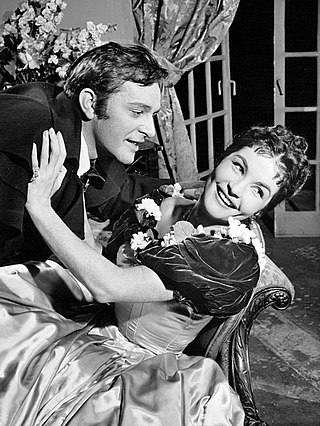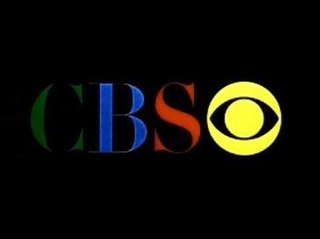Related Research Articles
The year 1955 in television involved some significant events. Below is a list of television-related events during 1955.
The year 1954 in television involved some significant events. Below is a list of television-related events in 1954.
The year 1953 in television involved some significant events. Below is a list of television-related events during 1953.

The Arthur Murray Party is an American television variety show which ran from July 1950 until September 1960. The show was hosted by famous dancers Arthur and Kathryn Murray, and was basically one long advertisement for their chain of dance studios. Each week the couple performed a mystery dance, and the viewer who correctly identified the dance would receive two free lessons at a local studio.

Lux Video Theatre is an American television anthology series that was produced from 1950 until 1957. The series presented both comedy and drama in original teleplays, as well as abridged adaptations of films and plays.

Boris Karloff (1887-1969) was an English actor. He became known for his role as Frankenstein's monster in the 1931 Frankenstein, leading to a long career in film, radio, and television.
The following is the 1958–59 network television schedule for the four major English language commercial broadcast networks in the United States. The schedule covers primetime hours from September 1958 through March 1959. The schedule is followed by a list per network of returning series, new series, and series cancelled after the 1957–58 season.
The 1955–56 network television schedule for the four major English language commercial broadcast networks in the United States. The schedule covers primetime hours from September 1955 through March 1956. The schedule is followed by a list per network of returning series, new series, and series cancelled after the 1954–55 season.

The Colgate Comedy Hour was an American comedy-musical variety series that aired live on the NBC network from 1950 to 1955. The show featured many notable comedians and entertainers of the era as guest stars. Many of the scripts of the series are archived at the UCLA Library in their Special Collections.
The following is the 1950–51 network television schedule for the four major English language commercial broadcast networks in the United States. The schedule covers primetime hours from September 1950 through March 1951. The schedule is followed by a list per network of returning series, new series, and series cancelled after the 1949–50 season. This season became the first in which primetime was entirely covered by the networks. It was also the inaugural season of the Nielsen rating system. Late in the season, the coast-to-coast link was in service.

Ford Star Jubilee is an American anthology series that originally aired monthly on Saturday nights on CBS at 9:00 P.M., E.S.T. from the fall of 1955 to the fall of 1956. The series was approximately 90 minutes long, broadcast in black-and-white and color, and was typically telecast live. Ford Star Jubilee was sponsored by the Ford Motor Company.
The 1949–50 network television schedule for the four major English language commercial broadcast networks in the United States. The schedule covers primetime hours from September 1949 through March 1950. The schedule is followed by a list per network of returning series, new series, and series cancelled after the 1948–49 season. This was the first season in which all four networks offered at least some prime time programming all seven nights of the week.
Ford Theatre, spelled Ford Theater for the original radio version and known, in full, as The Ford Television Theatre for the TV version, is a radio and television anthology series broadcast in the United States in the 1940s and 1950s. At various times the television series appeared on all three major television networks, while the radio version was broadcast on two separate networks and on two separate coasts. Ford Theatre was named for its sponsor, the Ford Motor Company, which had an earlier success with its concert music series, The Ford Sunday Evening Hour (1934–42).

Blondie is a radio situation comedy adapted from the long-running Blondie comic strip by Chic Young. It stars Arthur Lake as Dagwood Bumstead and, for the majority of its run, Penny Singleton as Blondie Bumstead. The radio program ran on several networks from 1939 to 1950.

Martin Ellyot Manulis was an American television, film, and theatre producer. Manulis was best known for his work in the 1950s producing the CBS Television programs Suspense, Studio One Summer Theatre, Climax!, The Best of Broadway and Playhouse 90. He was the sole producer of the award-winning drama series, Playhouse 90, during its first two seasons from 1956 to 1958.

DuPont Show of the Month was a 90-minute television anthology series that aired monthly on CBS from 1957 to 1961. The DuPont Company also sponsored a weekly half-hour dramatic anthology series hosted by June Allyson, The DuPont Show with June Allyson (1959–61).
The Chevrolet Tele-Theatre is an American anthology series that aired live on NBC Mondays at 8 pm EST from September 27, 1948 to June 26, 1950. The program presented both news headlines and live dramatic performances of either original plays or works adapted for television from the stage. Sometimes the show was referred to as Chevrolet on Broadway or The Broadway Playhouse; particularly when the program was presenting an adapted stage work from New York City's theatre scene.

CBS Thursday Night Movie was the network's first venture into the weekly televising of then-recent theatrical films, debuting at the start of the 1965–1966 season, from 9:00 to 11 p.m.. CBS was the last of the three U.S. major television networks to schedule a regular prime-time array of movies. Unlike its two competitors, CBS had delayed running feature films at the behest of the network's hierarchy. Indeed, as far back as 1960, when Paramount Pictures offered a huge backlog of pre-1948 titles for sale to television for $50 million, James T. Aubrey, program director at CBS, negotiated with the studio to buy the package for the network. Aubrey summed up his thinking this way: "I decided that the feature film was the thing for TV. A $250,000 specially-tailored television show just could not compete with a film that cost three or four million dollars." However, the network's chairman, William Paley, who considered the scheduling of old movies "uncreative", vetoed the Paramount transaction.
References
- ↑ Brooks, Tim; Marsh, Earle (1999). The Complete Directory to Prime Time Network and Cable TV Shows 1946-Present (7th ed.). New York: The Ballentine Publishing Group. p. 198. ISBN 0-345-42923-0.
- ↑ Terrace, Vincent (2011). Encyclopedia of Television Shows, 1925 through 2010. McFarland & Company, Inc. ISBN 978-0-7864-6477-7. P. 199.
- ↑ "Bill Goodwin, 47, Announcer on Radio, Dies". Chicago Tribune. May 10, 1958. Retrieved 22 July 2015.
- 1 2 "Colgate Theatre". Variety. January 10, 1949. p. 30. Retrieved January 2, 2023.